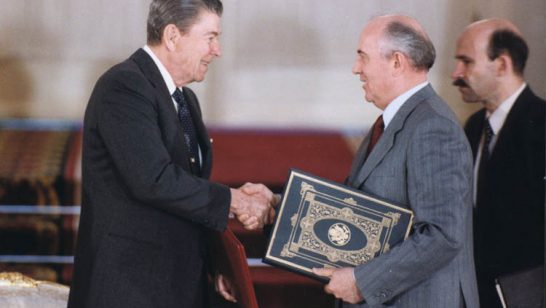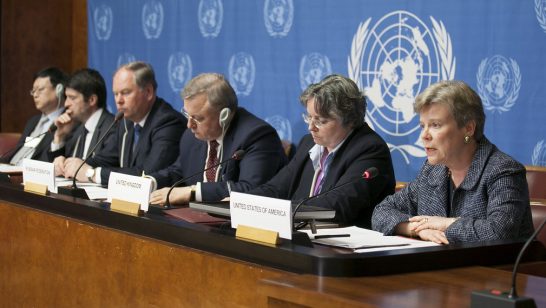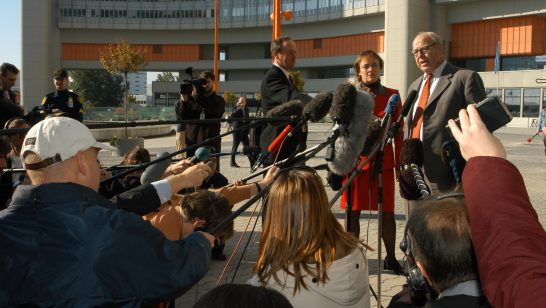
The use of a nuclear weapon is the most likely trigger for escalation to nuclear war, an outcome that threatens human survival. The most rational strategy in a nuclear-armed world, therefore, is to try to minimise the likelihood of nuclear use. The probability of nuclear use is lowest at nuclear zero, but that remains a distant prospect. Consequently, disarmament should be seen as an endpoint of zero and a process that can help reduce nuclear weapons-related risks on the path to zero by improving dialogue and mutual understanding, and through unilateral, bilateral, or multilateral measures to reduce the number and role of nuclear weapons in security strategies.
A risk-driven approach to nuclear disarmament acknowledges the national security concerns driving deterrence strategies, but highlights the responsibility of leaders in nuclear armed and allied states to address meaningfully the growing expert consensus that the likelihood of nuclear use by accident, miscalculation, or design is rising. To date, the political impact of widespread warnings to this effect has been limited by the data-poor, emotion-rich nature of nuclear threat assessments; pushback from powerful actors with vested interests in nuclear weapons enterprises; and the lack of a transparent, representative or coordinated approach to nuclear risk analysis. A Global Commission on Military Nuclear Risks—an independent, globally representative body of diverse, nongovernmental experts—could help to address these challenges by offering an authoritative assessment of the trend line in nuclear risk.
Deterrence theorists acknowledge the inescapable role of luck in contributing to nuclear outcomes, but nonetheless assume that human control practices are largely responsible for the historical record of non-use. In this sense, the strategy of nuclear deterrence assumes national leaders can and will use the means available to them to control escalation in way that prevents nuclear use indefinitely.
A risk-driven approach to nuclear disarmament begins with two observations: first, the credibility of the assumption that leaders can reliably control nuclear risks with the indefinite outcome of non-use—already a contested notion—appears to be in sharp decline. Factors challenging this assumption include, among other things, ongoing revolutions in military and dual-use technologies; declassified evidence suggesting canonical accounts of some cases of near-nuclear use overestimate the degree of human control over those outcomes; growing ‘strategic’ impacts from remote sensing technologies, and cyber and advanced conventional weapons; increasing entanglement of nuclear and non-nuclear military systems; a new, multipolar web of strategic deterrence relationships; the combination of social media nuclear signalling and deep fake videos; mutual US-Russian characterisation of each other’s nuclear doctrines as ‘warfighting’; and the medium-term impact of climate change on nuclear infrastructure. Some of these dynamics undermine the logic of nuclear restraint by increasing ‘use it or lose it’ pressures. Others expand the range of critical, escalatory factors that lie outside the bounds of human control.
Risk is generally defined as the likelihood of an unwanted outcome multiplied by its expected consequence. The use of nuclear weapons carries unavoidable and potentially existential consequences, so by definition, nuclear weapon-related risks are extreme and they vary according to changes in the likelihood of nuclear use. It is not possible to quantify that likelihood because we can cannot anticipate and account for all the scenarios that might lead to nuclear use. But it is possible to assess the trend line in the likelihood of nuclear use by monitoring three factors that negatively impact the controllability of nuclear escalation: the number, complexity and speed of ‘escalation nodes’.
Escalation nodes are actions or events that could link to form an escalation chain leading to the outcome of nuclear use, but which nuclear planners believe can reliably be manipulated by human or technology-based practices to maintain escalation control and ultimately, prevent that outcome. Logically speaking, as the number, complexity and speed of escalation nodes increase, the inherent controllability of nuclear outcomes decreases and the impact of luck on those outcomes grows in relative terms.
In a rational policymaking context, an increasing impact of luck on military nuclear outcomes and a declining reliability of nuclear control practices should result in a reduced political commitment to nuclear deterrence as a useful strategy for preventing nuclear use. That should lead, in turn, to an increased focus on alternative risk reduction and disarmament measures. But these developments would require a transparent, authoritative means of tracking nuclear risk.
One means to do this is to convene a Global Commission on Military Nuclear Risks. This Global Commission would first agree on a set of specific pathways that might plausibly lead to nuclear use, clearly defining in each case the precise chain of events and specific escalatory nodes along the chain. The Commissioners would then monitor these pathways according to their respective expertise, meeting regularly to update findings and seek consensus on the trend line in the likelihood of nuclear use. Overall increases in the number, complexity and speed of escalation nodes would suggest increasing military nuclear risk, and vice versa. Commissioners would feed their conclusions into domestic and international political processes through meetings with government officials, and promote their findings as tools for public outreach and education. A dedicated youth stream, such as the CTBTO Youth Group, could strengthen this educational work.
To maximise its credibility and impact, the Commission should be a globally representative group of 25-30 highly regarded, nongovernmental experts from nuclear armed and allied states, non-NPT countries, and non-nuclear armed states including from the Global South. Commissioners should be diverse in age, gender and expertise, encompassing ex-government and ex-military, academic, think tank and civil society nuclear experts, and specialists in risk analysis. To ensure its sustainability and independence, the Commission should establish a small secretariat and seek funding from a broad range of governmental and nongovernmental sources.
This format would distinguish the Global Commission from past commissions and risk assessments. Seventeen of the twenty experts who calibrate the Doomsday Clock, for example, are US-based, and it is unclear how they infer quantitative risk from qualitative analysis. The Canberra, Tokyo and WMD Commissions and the International Commission on Nuclear Non-proliferation and Disarmament produced authoritative, but very broad reports, making them prohibitively complex and expensive to replicate. These commissions were also unsustainable because they were tied to the political fortunes of specific governments.
Critics may object that some sources of risk will always be unforeseeable, so we can never truly account for the total amount of risk present. While this is true, ensuring the Commission’s diversity across a range of categories would help maximise the representativeness of findings and minimise bias in case selection and interpretation. Moreover, given the current trend line of destabilisation and massive military nuclear modernisation, there is an urgent need to find better ways to confront growing nuclear risks.
A Global Commission on Military Nuclear Risks would create opportunities for mutual learning about strategic assumptions and threat perceptions. It would strengthen the impetus for high-level political engagement by not only raising awareness of nuclear risks, but also identifying concrete, high-impact options for cooperative risk reduction efforts. The Commission could therefore help to rebuild habits of cooperation inside and outside the Non-Proliferation Treaty, and ease political tensions among nuclear armed and allied states by reinforcing confidence in the mutual desire to prevent nuclear war.
The opinions articulated above also do not necessarily reflect the position of the European Leadership Network or any of its members. The ELN’s aim is to encourage debates that will help develop Europe’s capacity to address pressing foreign, defence, and security challenge.
Note: The title of this commentary was changed on 6th February 2020 from “A risk-driven approach to nuclear disarmament” at the request of the author to better reflect the substance of the piece.



